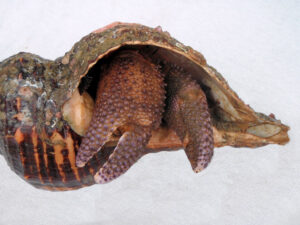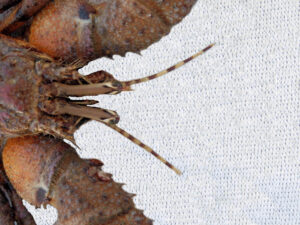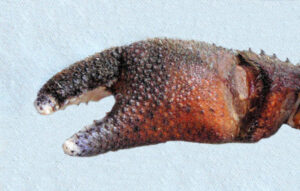Big Claw Purple Hermit Crab, Petrochirus californiensis



 Big Claw Purple Hermit Crab, Petrochirus californiensis. Crab, within a Panamic Horse Conch, Triplofusus princeps, shell provided by the Commercial Fishermen of the greater Los Cabos area, Baja California Sur, June 2009. Length: 18 cm (7.1 inches).
Big Claw Purple Hermit Crab, Petrochirus californiensis. Crab, within a Panamic Horse Conch, Triplofusus princeps, shell provided by the Commercial Fishermen of the greater Los Cabos area, Baja California Sur, June 2009. Length: 18 cm (7.1 inches).
General information: The Big Claw Purple Hermit Crab, Petrochirus californiensis, is a member of the Diogenidae Family of hermit crabs, that are sometimes referred to as “left handed hermit crabs” due to the left claw being larger than the right which is atypical of hermit crab species. In Mexico they are known as ermitanos and ermitano morado boxeador.
Identification: The Big Claw Purple Hermit Crab is the largest of the gulf hermit crab species sporting a rusty brown color, with their carapace length reaching 2.5 cm (1.0 inch) 7.5 cm (3.0 inches) in length. These crabs have heavy rough claws with pronounced knobs and the left is slightly larger than the right. The chelipeds are a reddish-purple color with white cutting edges and tips of the dactyls. They have Reddish-purple antennae with white segments. Their legs are a reddish-brown color and covered in numerous hairs color matched, their eyestalks are also reddish-brown with a white band just before the corneas. They occupy a variety of gastropod shells, most often Murex, Pleuroploca, and Strombus.
Habitat and Range: The Big Purple Hermit Crab resides in rocky and sandy substrates at depths between 3 m (10 feet) and 30.5 m (100 feet). They range from the Sea of Cortez all through Central America south to Ecuador. They are most often found in bays and within the mouth of estuaries during the winter and spring months.
Diet: Hermit crabs are omnivores and scavengers which means they’ll eat just about anything they can get their claws on including small invertebrates, fish, and plant matter.
Conservation Status: From a conservation perspective the Big Purple Hermit Crab has not been formally evaluated, however, they are fairly common, of limited interest to most, and can be considered to be of Least Concern.